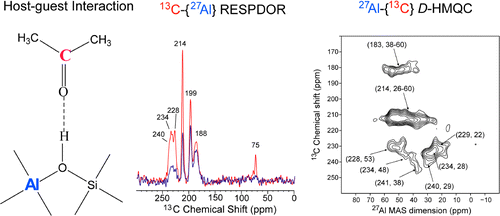Supported by the National Natural Science Foundation of China, Feng Deng’s group, affiliated with State Key Laboratory of Magnetic Resonance and Atomic and Molecular Physics, Wuhan Institute of Physics and Mathematics, proposed 13C-27Al MAS NMR techniques to investigate host–guest interactions during heterogeneous catalysis. (J. Phys. Chem. Lett. 2014, 5, 3068)
The widespread application of zeolite in petrochemical industry is mainly attributed to their high acid-catalyzed activity. Host–guest interactions between adsorbed molecules and acid sites strongly influence the performances (activity and selectivity) of catalysts because they play essential roles in the adsorption, desorption, as well as the catalytic reaction process. Even though the host–guest interactions between reactants and the acid sites could be easily demonstrated from the DFT theoretical calculations, the experimental evidence to describe this kind of interaction is still lacking so far.
Double-resonance 13C and 27Al NMR experiments are challenging due to their very close Larmor frequencies. With the assistance of a frequency splitter and advanced new NMR methods, new insights into the host–guest interactions are provided in heterogeneous catalysis systems. One-dimensional (1D) S-RESPDOR experiments are performed to quantitatively determine the carbon–aluminum distances. Additionally, the 27Al–{13C} dipolar-mediated hetero-nuclear multiple quantum correlation (D-HMQC) 2D spectrum permits us to confirm the nature of the 27Al sites near the carbonyl sites.
The combination of in situ MAS NMR and 27Al–{13C} S-RESPDOR experiments paves avenues for monitoring different reaction processes and elucidating the reaction mechanism in heterogeneous catalysis. The investigation of host–guest interactions will clarify the structure–property relationship during heterogeneously catalyzed reaction processes.
